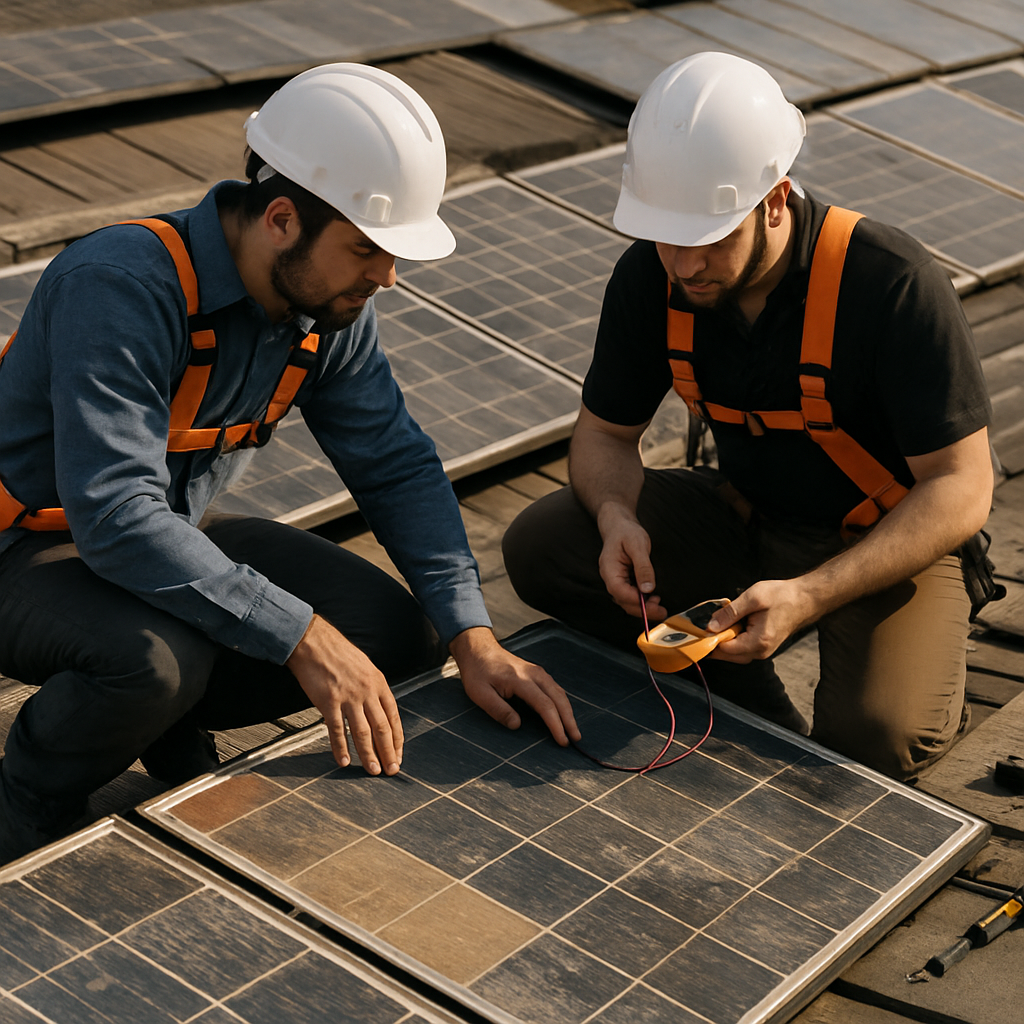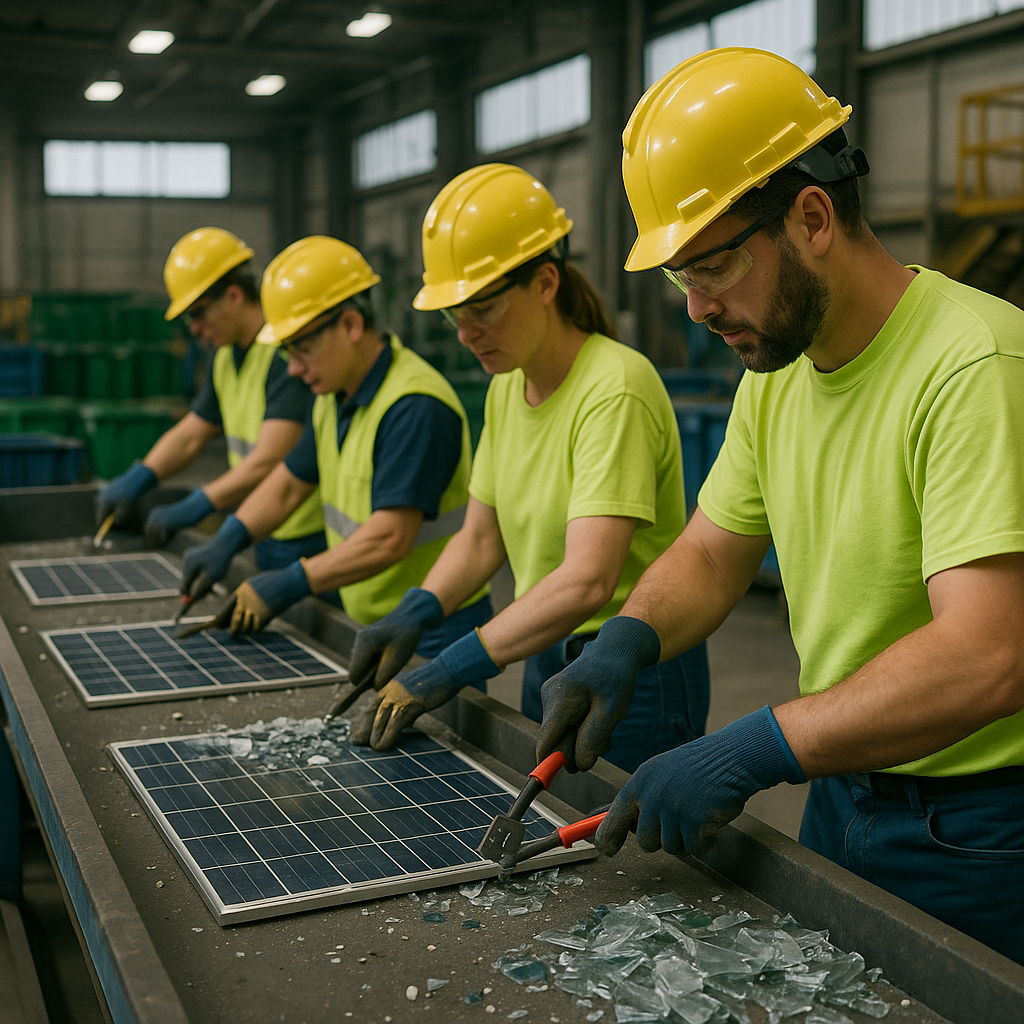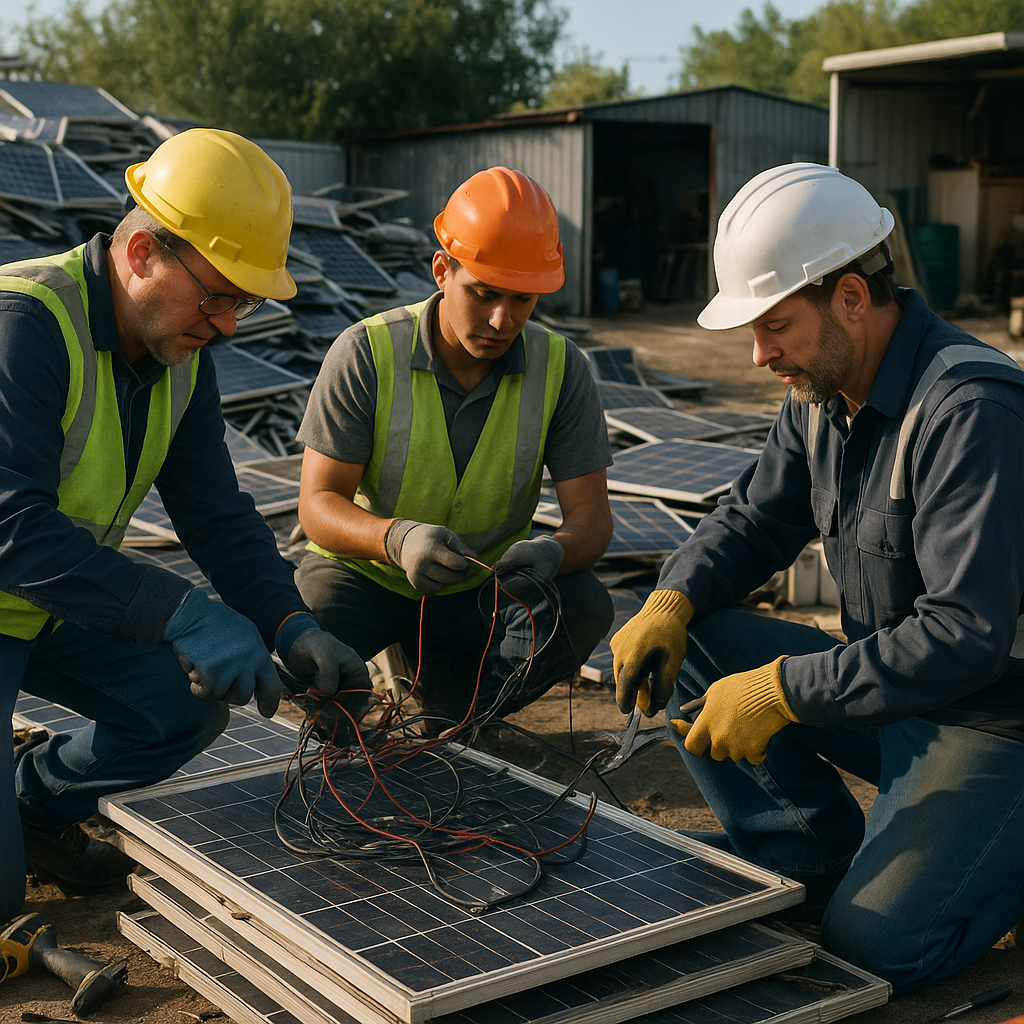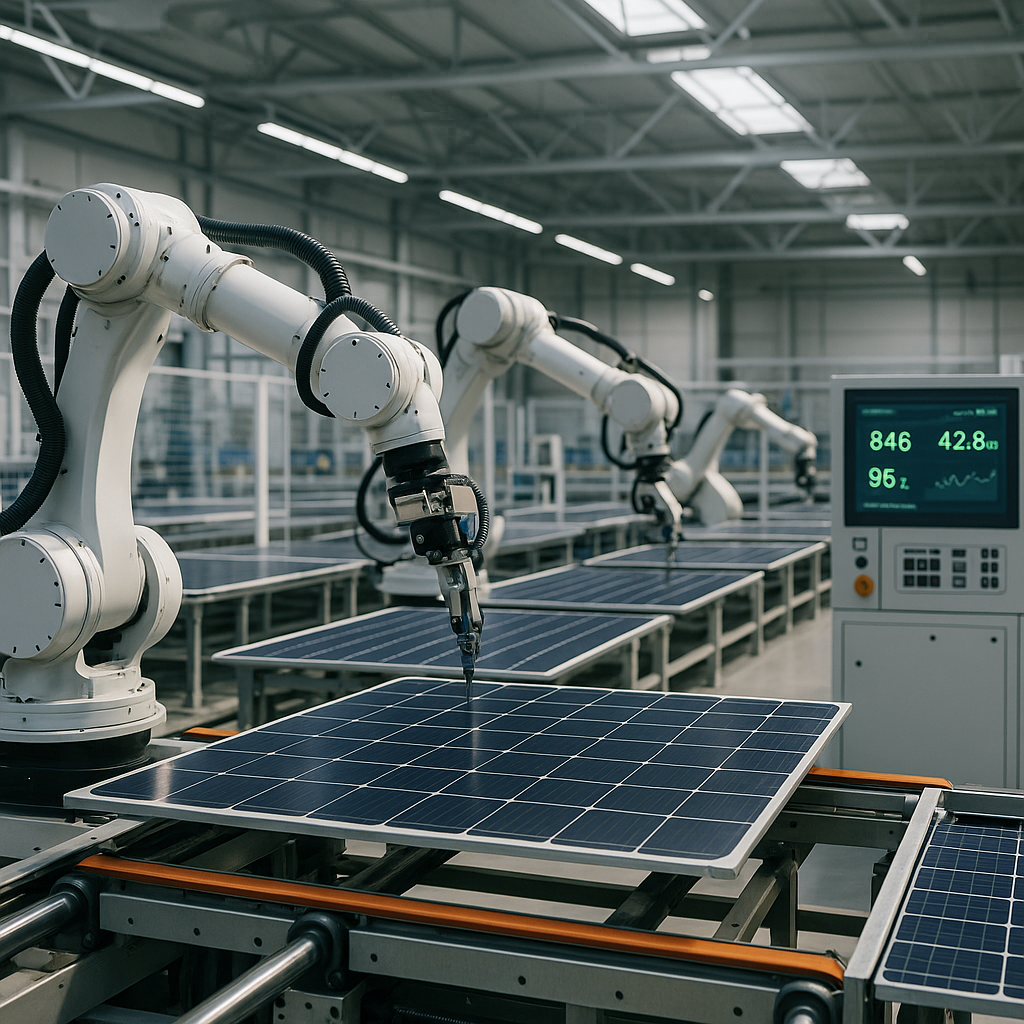5901 Botham Jean Blvd, Dallas, TX 75215
What Happens to Solar Panels After 25 Years? Efficiency & Recycling Explained
August 21, 2025The solar initiative that began in the early 2000s is approaching a pivotal milestone. Solar panels installed during that period are now nearing the end of their peak performance life. These silent energy producers consistently convert sunlight to electricity for decades before their efficiency starts to decline.
Most solar panels maintain reliable performance for 25-30 years. They don’t suddenly stop working at this age; instead, their efficiency gradually decreases by approximately 0.5% to 0.8% annually. After 25 years, a typical high-quality panel still operates at 80-90% of its original capacity.
This gradual decline presents an important decision point for panel owners and the solar industry. As millions of panels from the early solar boom approach retirement age, a new challenge emerges: how to responsibly manage these materials. The solar waste stream is projected to reach 80 million metric tons globally by 2050. Without proper recycling infrastructure, valuable resources could be wasted, and potentially harmful materials might end up in landfills. The rapidly growing solar recycling industry aims to recover the aluminum, glass, silicon, and precious metals from these panels, creating a truly circular clean energy economy.
What Happens to Solar Panel Efficiency Over Time?

Solar panels experience a gradual decline in electricity production as they age. This process, known as degradation, affects how much sunlight the panels can convert into usable energy. Most manufacturers design their warranty structures around an anticipated efficiency loss, typically guaranteeing 90% of the original production capacity for the first 10 years and 80% for the remaining 15-20 years.
The industry standard often cites an annual degradation rate of 0.5% to 0.8%, suggesting a 20% decrease in power capacity after 25 years. However, comprehensive research offers a more optimistic perspective. A study by the National Renewable Energy Laboratory (NREL) analyzed nearly 2,000 solar systems worldwide and found that modern monocrystalline panels manufactured after 2000 degrade by just 0.4% annually. This indicates that high-quality solar panels might lose only 6-8% of their efficiency after 25 years, significantly less than the 20% figure manufacturers base their warranties on.
Panel quality significantly affects degradation rates. Premium manufacturers like Panasonic and SunPower offer panels with degradation rates as low as 0.25% to 0.3% per year. At this rate, these high-end panels could still operate at 93% of their original capacity after 25 years. Standard tier-two panels with a 0.5% annual degradation would operate at around 88.7% efficiency, while budget options with 0.8% degradation might reduce to 82.5% capacity over the same period.
Several environmental factors contribute to panel degradation. Thermal cycling—the repeated expansion and contraction during temperature changes—creates microcracks in silicon cells over time. UV light exposure gradually damages panel materials and coatings. High humidity can alter conductivity if moisture penetrates the panel, while potential-induced degradation occurs when voltage differences between components cause leakage currents.
Geographic location also impacts degradation rates. Systems in regions with extreme temperature fluctuations or high humidity degrade faster than those in moderate climates. Research by PV Evolution Labs found systems in cooler, mountainous regions degraded at nearly half the rate (0.7%) compared to the average (1.47%) across all sites.
Despite this gradual efficiency loss, most solar panels continue producing electricity well beyond their 25-year warranty period. High-quality systems often remain functional for 30-40 years, though with diminishing output. The panels don’t suddenly fail at the 25-year mark—they simply become less efficient over time, maintaining around 80-90% of their original capacity.
This extended functional lifespan has important implications for waste management and recycling planning. Understanding real-world degradation patterns helps municipalities and businesses develop appropriate timelines for recycling infrastructure and end-of-life processing strategies.
| Manufacturer | Degradation Rate (% per year) | Expected Efficiency After 25 Years (%) |
|---|---|---|
| Panasonic | 0.25% | 93% |
| SunPower | 0.30% | 92.5% |
| Standard Tier Two | 0.50% | 88.7% |
| Budget Options | 0.80% | 82.5% |
How Are Solar Panels Recycled?

The solar panel recycling process begins with careful disassembly. Technicians first remove the aluminum frame and junction box, preserving these valuable components for immediate recovery. This initial step separates the most readily recyclable materials, accounting for approximately 19% of the panel’s total weight.
Once frames are removed, the panels move to a specialized separation process. Modern recycling facilities use mechanical methods to separate the glass cover from the underlying materials. Glass represents about 70% of a solar panel’s weight and achieves impressive recovery rates of up to 95%.
Thermal processing follows separation. The remaining panel components undergo controlled heating at around 500°C. This breaks down the ethylene vinyl acetate (EVA) that binds the various layers together, effectively removing plastic components and allowing access to the valuable materials beneath.
Chemical processing is the final major step. Specialized chemical treatments help recover semiconductor materials and precious metals. Silicon, the primary material in most solar cells, achieves recovery rates of approximately 85%. Other valuable metals like copper and silver also have high recovery rates.
Thin-film panels require a more intensive approach. These panels are shredded into small pieces before separation into solid and liquid components. Special equipment sorts these materials, enabling effective recovery of cadmium and tellurium that aren’t present in standard silicon panels.
The efficiency of the recycling process continues to improve with technological advancements. Current recovery rates reach up to 95% for glass, 95% for aluminum, and 85% for silicon. Some facilities have achieved overall material recovery rates exceeding 96% by mass, marking significant progress toward sustainable solar energy.
Advanced facilities increasingly use automated systems with robotics and artificial intelligence to optimize the separation process. These technologies enhance both processing speed and recovery rates. The final stage processes all recovered materials for reuse in new products, completing the circular economy cycle.
The economic viability of recycling improves with these higher recovery rates. The recovery of valuable materials like silver, copper, and aluminum helps offset processing costs. As more panels reach their end-of-life stage, the industry expects recycling operations to become increasingly cost-effective and environmentally beneficial.
| Component | Monocrystalline Panels | Polycrystalline Panels | Thin-Film Panels |
|---|---|---|---|
| Glass | 95% | 95% | 90% |
| Silicon | 85% | 85% | 92% |
| Aluminum | 95% | 95% | 95% |
| Silver | 90% | 90% | 95% |
| Copper | 90% | 90% | 90% |
What Are the Challenges in Solar Panel Recycling?

Solar panel recycling faces significant economic hurdles that limit widespread adoption. Recycling a single panel costs between $20 and $30, while landfill disposal is just $1 to $5 per unit. This substantial cost gap explains why recycling rates remain below 10% globally, despite growing environmental concerns.
The complex structure of solar panels creates technical challenges for recyclers. A typical panel contains multiple tightly bonded layers, including glass (75% by weight), aluminum frames (10%), polymer encapsulants (10%), and silicon cells with precious metals (5%). Separating these materials requires sophisticated processes that few facilities can perform economically.
Extracting high-value materials presents particular difficulties. Removing the ethylene-vinyl acetate adhesive requires temperatures above 400°C, while recovering silicon and silver demands specialized chemical treatments. These processes need significant energy inputs and specialized equipment not widely available.
The United States faces a serious infrastructure shortage for solar panel recycling. According to the Solar Energy Industries Association, only five companies in the country provide comprehensive recycling services. Most regions lack appropriate facilities, forcing long-distance transportation of panels and increasing costs.
Hazardous materials within some panels require careful handling during the recycling process. Panels may contain lead, cadmium, selenium, and other toxic substances that can leach into soil and groundwater if improperly managed. The EPA classifies some end-of-life panels as hazardous waste, requiring strict disposal protocols.
Regulatory inconsistencies across states create confusion for recyclers and solar panel owners. While Washington state has implemented manufacturer take-back requirements, most states have limited or no specific solar panel disposal regulations. This regulatory patchwork hampers the development of standardized recycling practices.
Small-scale recycling operations face particularly steep challenges. Most facilities are designed for utility-scale volumes, processing thousands of panels daily. Individual homeowners and small businesses often encounter higher per-unit costs and difficulty finding recyclers willing to accept small quantities.
Despite these barriers, promising innovations are emerging. Companies like ROSI Alpes in France have developed technologies capable of recovering up to 95% of panel materials with high purity levels. These advanced processes can extract semiconductor-grade silicon and other valuable components suitable for manufacturing new panels.
Research institutions and private companies are actively developing more cost-effective recycling methods. Thermal decomposition processes, advanced mechanical separation techniques, and chemical processing innovations are gradually improving recovery rates while reducing processing costs.
Industry collaborations are also addressing the infrastructure gap. Regional collection programs that combine panels from multiple sources help achieve the minimum volumes needed for economic processing, making recycling more accessible to smaller generators.
As early solar installations reach end-of-life in growing numbers, these challenges have taken on new urgency. Without expanded recycling capacity, the projected 78 million tons of solar panel waste by 2050 could undermine many of the environmental benefits solar energy provides.
While significant obstacles remain, the solar industry’s growing focus on developing circular economy solutions offers hope for more sustainable end-of-life management. Investments in recycling technology, evolving regulations, and increased awareness among stakeholders are gradually building momentum toward higher recycling rates and more responsible material management.
What is the Future of Solar Panel Recycling?

The solar panel recycling market is growing rapidly. Financial projections suggest that by 2050, the global value of recoverable materials from decommissioned panels will reach $15 billion. This economic opportunity is due to valuable components within panels—such as silicon, silver, copper, and aluminum—that can be extracted and reused in manufacturing new products.
This industry transformation is creating new green jobs across collection, transportation, processing, and material recovery. Large recycling facilities need skilled technicians, engineers, and logistics experts. A single 5-gigawatt recycling facility can process approximately 10 million panels annually, requiring substantial workforce development in specialized areas.
Technological innovations are improving recycling processes. Advanced separation techniques now achieve up to 98% recovery rates for critical materials. Thermal decomposition processes recover 95% of glass and 85% of silicon from panels. The integration of artificial intelligence and robotics has significantly improved efficiency, with AI-powered systems identifying different panel types and optimizing dismantling procedures while preserving valuable materials.
Chemical processing methods have evolved significantly. New electrochemical processes extract high-purity silicon and silver more efficiently than traditional methods. Ultrasonic delamination technologies separate glass without damaging other components. These advancements make recycling more economically viable while reducing environmental impact.
Regional growth patterns show Europe leading with nearly 40% market share due to stringent regulations. However, the Asia Pacific region is experiencing the fastest growth as China, Japan, and India see significant increases in solar installations and subsequent recycling needs. This regional diversification creates opportunities for global cooperation and knowledge sharing.
Challenges remain despite progress. The recycling industry must scale up to handle the projected 78 million tons of solar panel waste expected by 2050. Material recovery economics require further improvement, especially for panels with lower silver content. Facilities processing over 18,000 tons yearly can maintain profitability, but smaller operations find economic viability challenging.
Investment in research and development is crucial. Venture capital firms and environmental funds are financing innovative recycling technologies and regional processing centers. This financial support accelerates innovation across the recycling ecosystem, from collection to material processing.
The shift toward comprehensive recycling completes the renewable energy sustainability cycle. As technologies advance and market needs grow, solar panel recycling will move from a niche operation to an essential component of the clean energy economy. This transformation ensures that solar power remains a truly sustainable solution throughout its lifecycle.
| Region | 2024 Market Size (USD Million) | 2030 Projected Market Size (USD Million) | CAGR (2025-2030) |
|---|---|---|---|
| North America | – | – | 31.75% |
| Europe | 111.26 | – | – |
| Asia-Pacific | – | – | Fastest Growing |
| Global | 219.28 | 2,489.52 | 31.75% |
Conclusion: The Importance of Planning for Solar Panel End-of-Life
As the solar industry grows, effective end-of-life management of photovoltaic panels has become increasingly vital. With global installed capacity exceeding 1,000 gigawatts and projections of up to 78 million tons of solar panel waste by 2050, addressing this growing waste stream is urgent.
The sustainability of solar energy depends not only on clean power generation but also on managing panels after their 25-30 year lifespan. Proper planning and investment in recycling infrastructure will be essential for handling the upcoming wave of decommissioned panels. By recovering valuable materials like silicon, silver, aluminum, and copper, we can reduce the environmental footprint of solar energy and create economic opportunities in the circular economy.
The solar industry stands at a critical crossroads. Without proper recycling systems, discarded panels accumulate in landfills, undermining the sustainability of solar energy. However, technological advancements, policy support, and industry commitment can enable solar panel recycling to enhance, rather than detract from, solar’s environmental benefits. To truly deliver on its promise of clean energy, planning for responsible end-of-life management must become standard practice across the industry.
If you’re seeking expert guidance on responsible disposal and recycling options for your solar panels, contact Okon Recycling at 214-717-4083. Our team can help you navigate the complexities of solar panel recycling, ensuring your renewable energy solution remains sustainable throughout its lifecycle.
